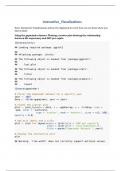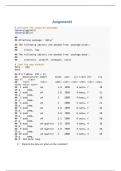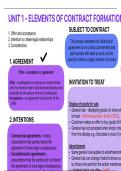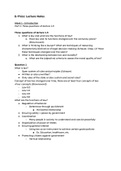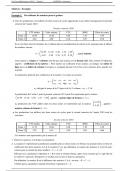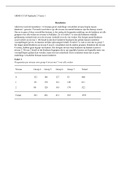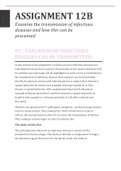Chapter 1: the nature of science and
physics
1.2 physical quantities and units
By giving numerical values for physical quantities and equations for physical principles, we can
understand nature much more deeply than just qualitative description → to understand these huge
series we must have units to express them → all physical quantities can become expressed as
combinations of only four fundamental physical quantities:
- length
- mass
- time
- electric current
How do we define a physical quantity: by specifying how it is measured or by indicating how it is
calculated based on other measurements → is expressed in terms of units = standardized values →
length of a match (physical quantity) expressed in meters or kilometers
- How do we define distance and time: by specifying methods to measure them
- How do we define average speed: by stating that it is calculated as distance traveled divided
by travel time.
Without standardized units, it would be extremely difficult for scientists to meaningfully express and
compare measured values
difference between quantities and units: quantity is the amount or numerical value, while the unit is
the measurement → 453 grams, the quantity is 453 while the unit is grams
There are two main systems of units used in the world:
- SI units
- the metric system
- uses powers of 10 to relate quantities over the vast ranges encountered in
nature.
- standard unit
- derived from the French Système International.
length mass time electric current
meter (m) kilogram (kg) second (s) ampère (A)
- English units
- the usual or imperial system
- used by USA
, some physical quantities are more fundamental than others and that the most basic physical quantities
can only be defined in terms of the procedure used to measure them
- fundamental units → length, mass, time and electric current
- derived units → force and electric charge → algebraic combinations of length, mass, time
and current → units you can express in base units
Second
The SI unit for time, the second (s) was first defined as ,400 of an average solar day → new
standard taken to get more accuracy and to define the second in terms of a non-varying or constant
physical phenomenon (because the solar day gets longer due to a very gradual slowing down of the
Earth's rotation) → accuracy in the fundamental units is essential, as all measurements are ultimately
expressed in terms of fundamental units and cannot be more accurate than the fundamental units
themselves.
Meter
The SI unit for length is the meter (m) first defined as ,000,000 → later defined as 1,650,763.73
wavelengths of orange light emitted by krypton atoms → the length of the meter will change as the
the speed of light is measured more accurately one day.
Kilogram
The SI unit for mass is the kilogram (kg) → was defined as the mass of a platinum-iridium cylinder
→ is now defined in terms of the second, meter, and Planck's constant, h (a quantum mechanical value
that relates the energy of a photon to its frequency).
Metric Prefixes
The term order of magnitude refers to the scale of a value expressed in the metric system → each
power of 10 in the metric system represents a different order of magnitude → all quantities that can be
expressed as a product of a specific power of 10 would be of the same order of magnitude: 800 can be
written as 8 × 10² and the number 450 can be written as 4.5 × 10² → the numbers 800 and 450 are of
the same order of magnitude: 10²
Look at the book for metric prefixes and symbols used to denote various factors of 10.
Often necessary to convert from one type of unit to another → Example: 80 m to km:
- write down which units you have and the units you want to go to → meters and kilometers
- determine conversion factor → a ratio that indicates how much of a unit is equal to another
unit → 1000 meters = 1 km
- make unit conversion → see photo
physics
1.2 physical quantities and units
By giving numerical values for physical quantities and equations for physical principles, we can
understand nature much more deeply than just qualitative description → to understand these huge
series we must have units to express them → all physical quantities can become expressed as
combinations of only four fundamental physical quantities:
- length
- mass
- time
- electric current
How do we define a physical quantity: by specifying how it is measured or by indicating how it is
calculated based on other measurements → is expressed in terms of units = standardized values →
length of a match (physical quantity) expressed in meters or kilometers
- How do we define distance and time: by specifying methods to measure them
- How do we define average speed: by stating that it is calculated as distance traveled divided
by travel time.
Without standardized units, it would be extremely difficult for scientists to meaningfully express and
compare measured values
difference between quantities and units: quantity is the amount or numerical value, while the unit is
the measurement → 453 grams, the quantity is 453 while the unit is grams
There are two main systems of units used in the world:
- SI units
- the metric system
- uses powers of 10 to relate quantities over the vast ranges encountered in
nature.
- standard unit
- derived from the French Système International.
length mass time electric current
meter (m) kilogram (kg) second (s) ampère (A)
- English units
- the usual or imperial system
- used by USA
, some physical quantities are more fundamental than others and that the most basic physical quantities
can only be defined in terms of the procedure used to measure them
- fundamental units → length, mass, time and electric current
- derived units → force and electric charge → algebraic combinations of length, mass, time
and current → units you can express in base units
Second
The SI unit for time, the second (s) was first defined as ,400 of an average solar day → new
standard taken to get more accuracy and to define the second in terms of a non-varying or constant
physical phenomenon (because the solar day gets longer due to a very gradual slowing down of the
Earth's rotation) → accuracy in the fundamental units is essential, as all measurements are ultimately
expressed in terms of fundamental units and cannot be more accurate than the fundamental units
themselves.
Meter
The SI unit for length is the meter (m) first defined as ,000,000 → later defined as 1,650,763.73
wavelengths of orange light emitted by krypton atoms → the length of the meter will change as the
the speed of light is measured more accurately one day.
Kilogram
The SI unit for mass is the kilogram (kg) → was defined as the mass of a platinum-iridium cylinder
→ is now defined in terms of the second, meter, and Planck's constant, h (a quantum mechanical value
that relates the energy of a photon to its frequency).
Metric Prefixes
The term order of magnitude refers to the scale of a value expressed in the metric system → each
power of 10 in the metric system represents a different order of magnitude → all quantities that can be
expressed as a product of a specific power of 10 would be of the same order of magnitude: 800 can be
written as 8 × 10² and the number 450 can be written as 4.5 × 10² → the numbers 800 and 450 are of
the same order of magnitude: 10²
Look at the book for metric prefixes and symbols used to denote various factors of 10.
Often necessary to convert from one type of unit to another → Example: 80 m to km:
- write down which units you have and the units you want to go to → meters and kilometers
- determine conversion factor → a ratio that indicates how much of a unit is equal to another
unit → 1000 meters = 1 km
- make unit conversion → see photo

